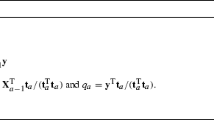Abstract
Spectral signals often suffer from the common problems of band overlap and random Gaussian noise. To address these problems, we propose a sparsity regularization-based model that deconvolutes the degraded spectral signals. Sparsity regularization is achieved by fitting the probability density function of the gradient of the signal, and then, the iteratively reweighted least-squares method is used to solve the minimization problem. Results from experiments using real spectral signals showed that this algorithm separates the overlapping peaks and effectively suppresses the noise. The deconvoluted spectral signals will promote the practical application of infrared spectral analysis in the fields of target recognition, material identification, and chemometrics analysis.






Similar content being viewed by others
References
F. Alsmeyer, W. Marquardt, Automatic generation of peak-shaped models. Appl. Spectrosc. 58(8), 986–994 (2004)
R. Bhargava, Infrared spectroscopic imaging: the next generation. Appl. Spectrosc. 66(10), 1091–1120 (2012)
R.E. Carrillo, K.E. Barner, Iteratively re-weighted least squares for sparse signal reconstruction from noisy measurements. in Information Sciences and Systems, 2009. CISS 2009. 43rd Annual Conference on, 18–20 March 2009 2009, pp. 448–453
P.A. Jansson, Deconvolution of images and spectra (Academic Press, New York, 1997)
J.K. Kauppinen, D.J. Moffatt, H.H. Mantsch, D.G. Cameron, Fourier self-deconvolution: a method for resolving intrinsically overlapped bands. Appl. Spectrosc. 35(3), 271–276 (1981)
V.A. Lórenz-Fonfría, E. Padrós, Maximum entropy deconvolution of infrared spectra: use of a novel entropy expression without sign restriction. Appl. Spectrosc. 59(4), 474–486 (2005)
V.A. Lórenz-Fonfría, E. Padrós, The role and selection of the filter function in fourier self-deconvolution revisited. Appl. Spectrosc. 63(7), 791–799 (2009)
A. Levin, R. Fergus, F.D. Durand, W.T. Freeman, Image and depth from a conventional camera with a coded aperture. ACM Trans. Graph. 26(3), 70 (2007). doi:10.1145/1276377.1276464
H. Liu, T. Zhang, L. Yan, H. Fang, Y. Chang, A MAP-based algorithm for spectroscopic semi-blind deconvolution. Analyst 137(16), 3862–3873 (2012)
H. Liu, Z. Zhang, J. Sun, S. Liu, Blind spectral deconvolution algorithm for Raman spectrum with Poisson noise. Photon. Res. 2(6), 168–171 (2014). doi:10.1364/PRJ.2.000168
H. Liu, Z. Zhang, S. Liu, J. Shu, T. Liu, L. Yan, T. Zhang, Spectral blind deconvolution with differential entropy regularization for infrared spectrum. Infrared Phys. Technol. 71, 481–491 (2015)
H. Liu, Z. Zhang, S. Liu, J. Shu, T. Liu, T. Zhang, Blind spectrum reconstruction algorithm with L0-sparse representation. Meas. Sci. Technol. 26(8), 085502 (2015)
H. Liu, Z. Zhang, S. Liu, L. Yan, T. Liu, T. Zhang, Joint baseline-correction and denoising for Raman spectra. Appl. Spectrosc. 69(9), 1013–1022 (2015)
H. Liu, M. Zhou, Z. Zhang, J. Shu, T. Liu, T. Zhang, Multi-order blind deconvolution algorithm with adaptive Tikhonov regularization for infrared spectroscopic data. Infrared Phys. Technol. 71, 63–69 (2015)
H. Liu, Z. Zhang, S. Liu, J. Shu, T. Liu: Parametric spectral signal restoration via maximum entropy constraint and its application. Paper presented at the 2015 IEEE Signal Processing and Signal Processing Education Workshop (SP/SPE), Salt Lake City, Utah, USA, August 9–12, 2015
V.A. Lorenz-Fonfria, E. Padros, Curve-fitting overlapped bands: quantification and improvement of curve-fitting robustness in the presence of errors in the model and in the data. Analyst 129(12), 1243–1250 (2004)
J. Ma, J. Zhao, J. Tian, A.L. Yuille, Z. Tu, Robust point matching via vector field consensus. IEEE Trans. Image Process. 23(4), 1706–1721 (2014). doi:10.1109/TIP.2014.2307478
J. Ma, W. Qiu, J. Zhao, Y. Ma, A.L. Yuille, Z. Tu, Robust L2E estimation of transformation for non-rigid registration. Signal Process. IEEE Trans. 63(5), 1115–1129 (2015). doi:10.1109/TSP.2014.2388434
J. Ma, J. Zhao, Y. Ma, J. Tian, Non-rigid visible and infrared face registration via regularized Gaussian fields criterion. Pattern Recogn. 48(3), 772–784 (2015). doi:10.1016/j.patcog.2014.09.005
L.J. Meng, D. Ramsden, An inter-comparison of three spectral-deconvolution algorithms for gamma-ray spectroscopy. Nucl. Sci. IEEE Trans. 47(4), 1329–1336 (2000)
NASA: Absorption Spectral Data of Cr:LiSAF Crystal. http://aesd.larc.nasa.gov/gl/laser/spectra/spectra.htm
J. Ottaway, J.H. Kalivas, E. Andries, Spectral multivariate calibration with wavelength selection using variants of tikhonov regularization. Appl. Spectrosc. 64(12), 1388–1395 (2010)
S. Roques, K. Bouyoucef, L. Touzillier, J. Vigneau, Prior knowledge and multiscaling in statistical estimation of signal-to-noise ratio—application to deconvolution regularization. Signal Process. 41(3), 395–401 (1995)
Y. Senga, K. Minami, S. Kawata, S. Minami, Estimation of spectral slit width and blind deconvolution of spectroscopic data by homomorphic filtering. Appl. Opt. 23(10), 1601–1608 (1984)
Y. Sun, C. Ridge, F. del Rio, A.J. Shaka, J. Xin, Postprocessing and sparse blind source separation of positive and partially overlapped data. Signal Process. 91(8), 1838–1851 (2011)
M. Van Droogenbroeck, Generalized iterative algorithm for spectral signal deconvolution, in Signal Processing, ed. by J.V.B. Moonen, A. Oosterlinck (Elsevier, Oxford, 1992), pp. 1389–1392
Q. Wang, D.D. Allred, L.V. Knight, Deconvolution of the Raman Spectrum of amorphous carbon. J. Raman Spectrosc. 26(5), 1039–1043 (1995)
L. Yan, H. Liu, S. Zhong, H. Fang, Semi-blind spectral deconvolution with adaptive Tikhonov regularization. Appl. Spectrosc. 66(11), 1334–1346 (2012)
J. Yuan, Z. Hu, G. Wang, Z. Xu, Constrained high-order statistical blind deconvolution of spectral data. Chin. Opt. Lett. 3(9), 552–555 (2005)
J. Yuan, Z. Hu, High-order statistical blind deconvolution of spectroscopic data with a Gauss-Newton algorithm. Appl. Spectrosc. 60(6), 692–697 (2006)
Acknowledgments
The authors thank the editor and anonymous reviewers for their valuable suggestions. This research was partially funded by the National Natural Science Foundation of China under Grant (No. 61505064), the National Social Science Fund of China (14BGL131), the Project of the Program for National Key Technology Research and Development Program (2013BAH18F01, 2014BAH22F01, 2015BAK07B03), the Self-Determined Research Funds of CCNU from the Colleges’ Basic Research and Operation of MOE (CCNU15A05009, CCNU15A05010, CCNU15A05059), and the Project of the Program for National Key Technology Research and Development Program (2013BAH72B01, 2013BAH18F02, 2015BAH33F02). The authors sincerely thank Prof. Yuan Jinghe for his helpful discussions and providing the source codes of FSD and HOS methods.
Author information
Authors and Affiliations
Corresponding author
Additional information
Hai Liu and Zhaoli Zhang have contributed equally to this work.
Rights and permissions
About this article
Cite this article
Liu, H., Yan, L., Huang, T. et al. Blind Spectral Signal Deconvolution with Sparsity Regularization: An Iteratively Reweighted Least-Squares Solution. Circuits Syst Signal Process 36, 435–446 (2017). https://doi.org/10.1007/s00034-016-0318-3
Received:
Revised:
Accepted:
Published:
Issue Date:
DOI: https://doi.org/10.1007/s00034-016-0318-3




